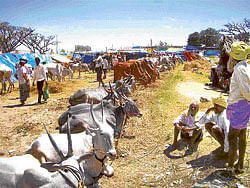Beasts of burden weigh heavily on farmers

The trend is becoming evident at annual cattle fairs held at taluk and district levels. One prime example is the week-long annual cattle fair organised as part of the Bhoganandeeshwara Brahmarathotsava at Nandi village of the taluk.
The phenomenon assumes significance in the light of greater stress on organic farming in Karnataka and the fact that cattle dung is used as manure.
The trend is attributed to the increasing use of modern implements and technology in agriculture.
Machines are replacing bullocks as they can do the job much faster than the beasts of burden.
District veterinary officer Manjunatha Reddy told Deccan Herald that with the government providing subsidy for purchasing modern agricultural implements, the demand for cattle was going down. With the cost of cattle care as also the cost of living of farmers going up, the farmers are opting for modern implements, he said.
Even those farmers who still fall back on oxen for tilling their lands are going for hybrid varieties. Time was when people thronged the fairs to sell their cattle. But recent fairs are recording plummeting numbers of both the farmers and the cattle.
At the annual fair in Nandi village, farmers from neighbouring states like Andhra Pradesh and Tamil Nadu, as also other districts in the State like Gadag, Haveri and Bellary used to buy the oxen. But, of late, the number of visitors to the fair is falling. The prices of the cattle have also shot up, said Nagaraja, a farmer from Devanahalli taluk.
“Usually, we stay in the village till the fair gets over. Food arrangements are made for the visitors. The price ranges from Rs 30,000 to Rs two lakh per pair of cattle. Sometimes, we get good business. Otherwise we suffer huge losses,” he said.
Manjunatha Reddy fears the population of the native breeds will decrease further in the next two decades.
In Chikkaballapur taluk alone, the cattle population fell from 25,708 in 1997 to 12,691 in 2007. The trend is no different in the rest of the State.
Reddy said they were now preserving the sperms of native cattle breeds, in a bid to increase their population. They were also creating awareness among the farmers about the importance of protecting the native breeds, he added.